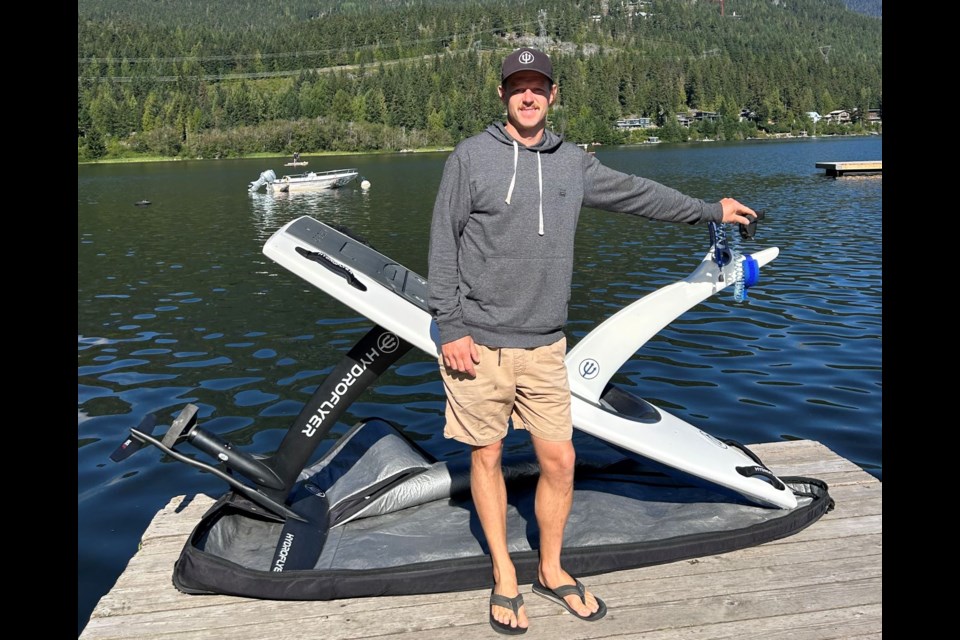Leave it to a Pembertonian like Jerry McArthur to ask questions like: "what if I added handlebars to a surfboard?"
That may be a slight oversimplification of McArthur's latest product, but you get the idea.
The Hydroflyer is essentially a cross between a Jet Ski and an electric foil (e-foil) surfboard, propelled by a 7.5-horsepower motor. A submerged wing mounted to the craft's bottom allows it to rise more than three feet into the air as it approaches a top speed of 50 km/h. The deck upon which you stand contains a lithium-ion battery capable of yielding two hours of runtime and safeguarded by three layers of waterproofing.
While the Hydroflyer isn't the fastest watercraft you could buy with $15,000 of disposable income, it is remarkably user-friendly—though that wasn't McArthur's original goal.
"I designed this because I wanted more control. I wanted to be able to go fast, be more aggressive and do jumps, that kind of thing," he revealed. "So it was really made to be a performance craft. The fact that it's approachable to beginners is not something we really set out to do in the first place … just the added benefit of the design.
"I've been teaching people to e-foil for seven years, and it always made me pretty nervous. With this one, I give people five or 10 minutes of instructions and off they go."
As a professional sports journalist, I had to test McArthur's claims. That's why I met up with him to put the Hydroflyer through its paces.
I believe I can fly
Courteous and professional, McArthur explained the basic principles of Hydroflyer operation during our short-notice rendezvous at Lakeside Park. I mentioned that, unlike him, I had not grown up riding mountain bikes or snowmobiles, but he appeared confident his device would suit my skill level. Then he handed me a wetsuit.
I'd actually never donned a wetsuit before, so it took me a few minutes of fumbling around in the men's bathroom before heading back to the dock. McArthur placed the Hydroflyer on its lowest power setting and held it in place while I climbed on board. Then, it was all up to me.
My first pump of the throttle pushed the Hydroflyer forward in a jerky manner. It took me four or five more tentative attempts before I decided to apply some consistent gas, and that's when I took off at eight km/h. The faster I went, the more stable the craft became, just as McArthur had said.
But there was a problem. Unlike a bicycle, the Hydroflyer's handlebars are fixed in place and there's no steerable rudder. I meandered into shallow water wondering how to turn.
McArthur, standing on the dock a few dozen metres away, reminded me I needed to lean my body left and right to control direction. Fortunately, my nascent skiing abilities had prepared me for this task, and before long I was carving wide, sweeping turns through the middle of Alta Lake. That emboldened me to go for a bit more speed, and the Hydroflyer ascended above the water.
Once I let off the gas, however, I came crashing back down and fought to absorb impact. Turns out: smooth and delicate throttle control is key.
I only fell off the Hydroflyer a single time, when my fingers slipped and punched the gas at a moment I wasn't intending to. Otherwise, it was smooth sailing.
Changing the e-foil game
McArthur discovered inspiration for the Hydroflyer in Australia. A post-high school gap year of surfing Down Under brought him into contact with e-foils, but he found most existing models too cumbersome for his liking.
That's when he decided to flex his entrepreneurial streak.
Since early childhood, McArthur's head has been full of ideas he's wanted to bring to life. His first invention as a grown-up was a reusable lid meant to attach to the tops of beer cans: a humble tool, but one that taught him his first lessons about how to make and market items.
"Thank God the Hydroflyer wasn't my first product, or it would have just been so overwhelming. I think it would have killed me," said McArthur.
Tapping into his Pembertonian upbringing, McArthur strapped a mountain bike to a hydrofoil and added some flotation devices. That was his prototype, and it opened his eyes to a whole new realm in the watersports world.
Development on the Hydroflyer began in earnest three or four years ago. Approximately 150 have been sold, all of them the standard "Cruiser" model, but beginner-oriented "Inflatable" and high-end "Sport" variants are in the works. All three could be ideal for the adventurous and athletic spirit of the Sea to Sky.
From WIRED Magazine to season 16, episode 3 of Dragon's Den, McArthur has done the legwork in promoting his brainchild. It's not always easy to run a business from a village, but he remains loyal to his home even as his level of exposure continues to increase.
McArthur still coaches with the Pemberton Youth Soccer Association (PYSA), just as his mom Anne Crowley did for 30 years, and he's got advice for the region's young would-be inventors.
"Your first idea is always going to need improvement, so start making it, see if it works and try to figure out if people are going to buy it without spending all your money on it first," McArthur said.




